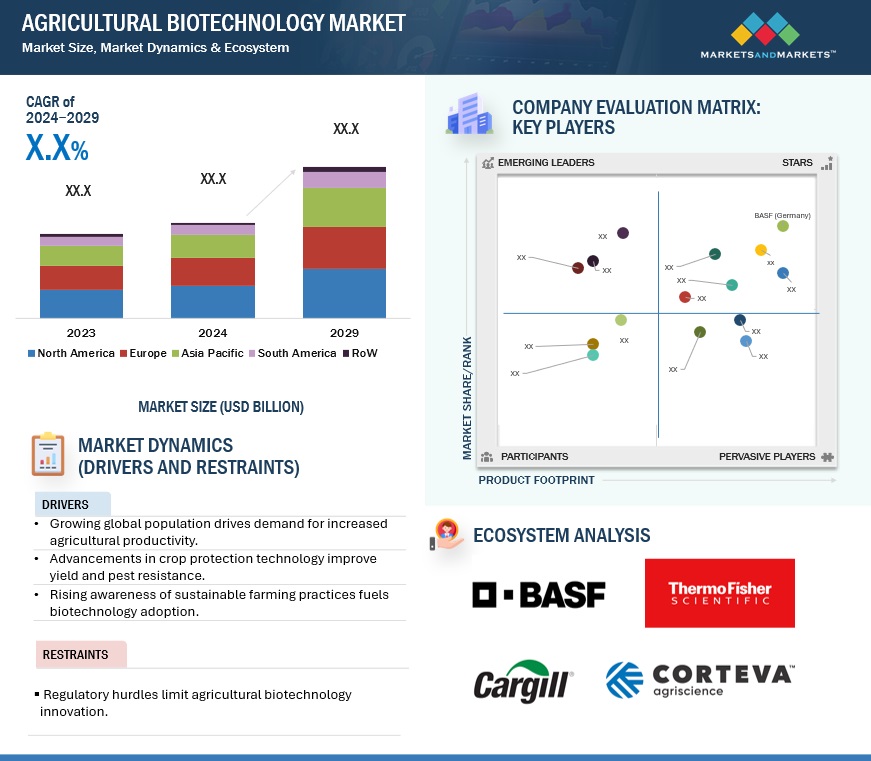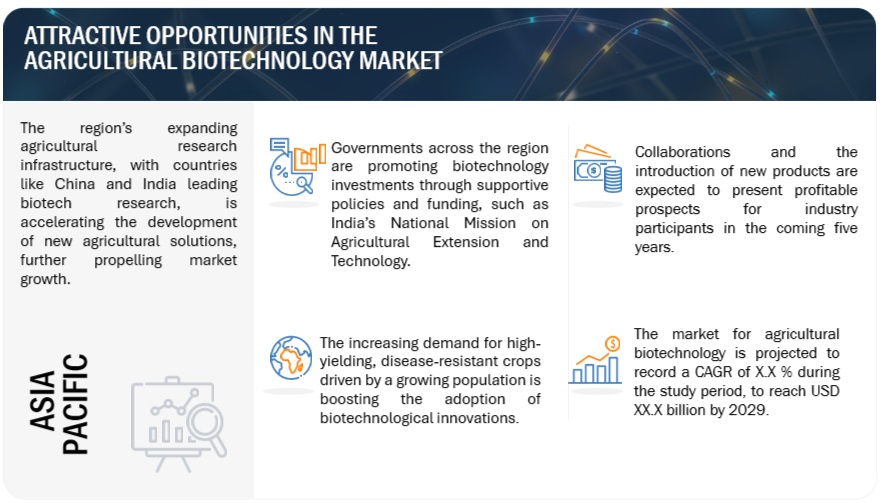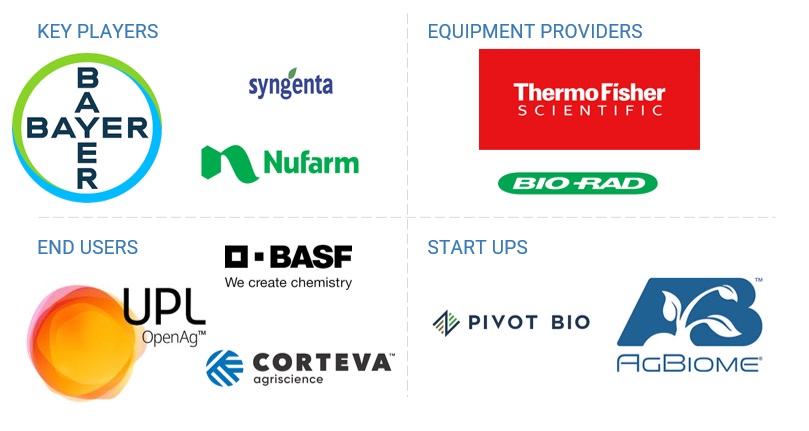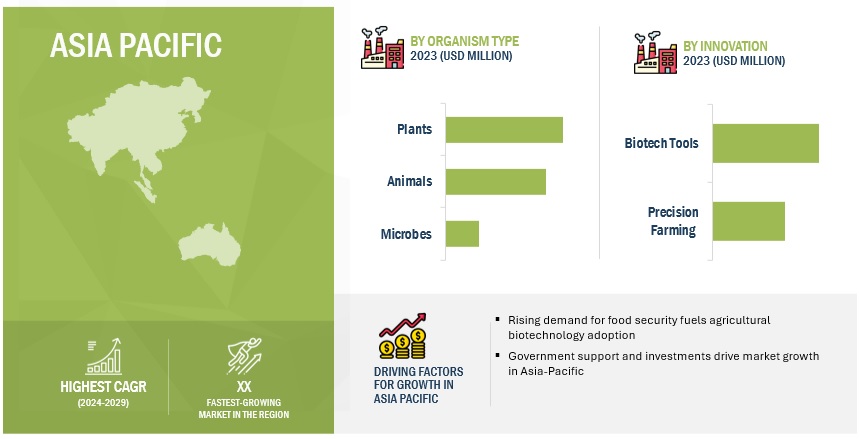Agricultural Biotechnology Market - Global Forecast to 2029
The agricultural biotechnology market is estimated at USD XX.X billion in 2024 and is projected to reach USD XX.X billion by 2029, at a CAGR of X.X % from 2024 to 2029. Agricultural biotechnology market has expanded significantly around the world due to the heightened demand regarding food security, the impact of climate change, and enhancement of sustainability in farming practices. This innovation is capable of yielding crops modified through genetic intervention and resistant to pests, diseases and environmental stresses, thus increasing crop yield with minimal pesticide dependence. With further exploding population around the globe, agricultural biotechnology can offer remedies in producing more using fewer inputs, making agriculture efficient. Many breakthroughs in gene editing, plant breeding, and biopesticides have expanded the scope even more in agricultural biotechnology.

To know about the assumptions considered for the study, Request for Free Sample Report

To know about the assumptions considered for the study, download the pdf brochure
Drivers: Rising world population and hunger index is driving demand for agricultural biotechnology market
According to UN report, the global population rose to 8.0 billion in November 2022 after a phenomenal growth rate of 2.5 billion in 1950 and is projected to reach 9.7 billion by 2050, peak at 10.4 billion in the mid-2080s. However, this increase is still synchronized with a surge in world hunge. In 2021, 828 million people faced hunger; that is, 46 million more than in 2020 and 150 million since the start of the COVID-19 pandemic (WHO, July 2024). This increasing population and degrading food situation need for intense work on innovations for the suppression of world hunger.
Agricultural biotechnology has tremendous potential against these challenges. Biotechnology can enhance crop yields significantly by making it possible for crop developers to develop GM crops which are resistant towards pest, diseases, and environment stresses. It would also help to make crops more nutritious, thereby contributing to overcoming malnutrition. Biotech innovations in the form of drought-tolerant and pest-resistant crops enhance the ability to produce food in areas of resource constraints, thereby enhancing food security. Demand in the agricultural biotechnology market arises, as governments, companies, and farmers strive to expand their productivity and fulfill food requirements for an expanding world population that also tackles the hunger crisis?.
Restraint: Regulatory challenges and patent issue
Main hindrances include regulatory barriers. In the European market, strict regulations result in long delays to biotech companies. Since different nations employ dissimilar GM crop approval procedures, the processes delay as well as limit the biotechnological products' global commercialization?. Agriculture and intellectual property rights, which relate to patent issues as well as ownership of seeds, are common amongst the serious issues that biotech companies face. Indeed, such IP rights disputes can make innovation complicated as companies may be less likely to share research or collaborate with other firms because they fear that their research will be helping somebody infringe on patents or worse, lose control over proprietary technologies. Besides this, when patents are owned by some large players, medium-sized companies or start-ups face a highly discriminating entry into the market and, consequently, limit overall innovation and slow down the industry's movement.
Opportunity: Genetically modified crops
Agricultural biotechnology has brought up a variety of opportunities: genetically modified crops to protect crops, increase yield, and achieve sustainability. Bayer Ag’s (Germany) InVigor® canola is one of those examples, genetically engineered to provide resistance against flea beetles. It is supposed to enhance yields even under unfavorable conditions and includes Pod Shatter Reduction technology, which safeguards yield potential at harvest. InVigor hybrids also provide with LibertyLink; this allows growers to rotate non-selective herbicides to manage weed resistance more effectively.
Another significant opportunity is Roundup Ready crops by Monsanto (US), in the form of a genetically modified soybean, corn, and canola that are glyphosate resistant. This could significantly allow proper management of the weeds during farming operations. Generally, those GM crops tend to support increased food production as well as promote solutions for most the global agricultural challenges, including pest resistance, climate change, and food security. As biotechnology continues to advance, it will bring more opportunities to the farmer, thus providing additional benefits both to the farmer and to the food systems around the world.
Challenge: High Development cost
Several challenges face the agricultural biotechnology market. One of the major barriers is the high cost of development. It takes a lot of funding to create new biotech products, which include research, testing, and regulatory approvals, often running into millions of dollars. High innovation costs can discourage small companies from entering the market, thus slowing the overall industry progress.
There are also issues of public perception and regulatory approvals for GM crops, which is quite different between countries. While biotechnology has been adopted by regions within other parts of the world, tight regulations have imposed on the market, limiting growth within the European Union, which is an example of such a region with strict policies towards this sector. Another challenge is the pest resistance to genetically modified traits, which may constrain the effectiveness of biotech crops overtime. These factors, coupled with the complications in supply chains and environmental issues, continue to form barriers to the widespread uptake of agricultural biotechnology.
Crop protection application holds largest share in application segment in the agricultural biotechnology market.
The crop protection segment has the largest market share in agricultural biotechnology. These are attributed to greater protection against pests and diseases, as well as stressors associated with environmental conditions. Companies such as Corteva(us) have led the innovation curve with solutions such as genetically engineered pest-resistant crops and microbial-based biologicals, which are better alternatives than chemical pesticides for use on crops. As depicted, it is also clear that biotechnology has greatly been instrumental in boost crop protection. Corteva's Qrome corn are resistant to several key insect pests. The resultant high demand in integrated pest management solutions, occasioned by the emergence of resistant pests will further enhance the adoption of biotechnological innovations in crop protection, which enables farmers to get better yields without significant unfavorable impacts on the environment.
The genetic engineering segment holds the largest share by technology segment in the agricultural biotechnology market.
Genetic engineering was the largest technology segment in the agricultural biotechnology market. This is attributed to the fact that GM crops have seen the deployment of increases in their pest, disease, and environmental stress resistance, thus yield. Importantly, genetic engineering has dominated the production of crops that have improved agricultural productivity significantly, such as Bt cotton and Roundup Ready soybeans. These developments in this field are still expanding, and new GM crops have been developed to give some drought resistance, pest control, and improved nutritional content. Such advancements are crucial to battle the issues presented by climate change and food security, which makes genetic engineering at the forefront of the market for agricultural biotechnology.

The North America region is anticipated to experience the largest share between 2024 and 2029.
The north America leads in global agricultural biotechnology market share, mainly because of strong research investments, technological superiority, and a friendly regulatory setting. Innovations through biotech have garnered significant support from the U.S. government, which funded the Agricultural Biotechnology Education and Outreach Initiative with USD 7.5 million, an initiative led by the U.S (according to U.S. Food and Drug Administration July 2024 article). The FDA, through its partnership with the U.S. Department of Agriculture (USDA) and the Environmental Protection Agency (EPA), conducts various activities intended to raise public awareness and understanding on agricultural biotechnology, especially those concerning genetically engineered food and animal feed ingredients. Such initiatives demonstrate a region's commitment to educating its citizens and pushing for biotech answers in agriculture.
Moreover, the region has a strong infrastructure, excellent research centers, and top biotech companies such as FMC Corporation (US), DuPont (US), and Arcadia Biosciences (US) which have been behind the development and commercialization of GM crops. These have been at the forefront in introducing GM crops that bring enhanced yield, increased resistance to disease, and increased nutritional content, an area the region enjoys a leading edge in agricultural biotechnology. Given the extraordinary rates of continuous investments in strong R&D, encouraging policies, and a healthy biotech ecosystem, this region captures the largest shares.

Key Market Players
- BASF (Germany)
- Syngenta Crop Protection AG (Switzerland)
- Bayer AG (Germany)
- FMC Corporation (US)
- Corteva (US)
- DuPont (US)
- Evogene Ltd. (Israel)
- Nufarm (Australia)
- ADAMA (Israel)
- Valent BioSciences LLC (US)
- KWS SAAT SE & Co. KGaA (Germany)
- AgBiome, Inc. (US)
- Biotalys NV (Belgium)
- Arcadia Biosciences (US)
- Limagrain (France).
These market players are focusing on increasing their presence through agreements and collaborations. These companies have a strong presence in North America, Asia Pacific, and Europe. They also have manufacturing facilities along with strong distribution networks across these regions.
Recent Developments
- In July 2024, ADAMA (Israel) entered into a partnership with Elemental Enzymes (US) to introduce a new biofungicide with patented peptide technology. The product will help control foliar diseases on crops such as wheat and canola and is due for release in 2026. The partnership enlarged the biological portfolio of ADAMA, providing new opportunities for growers to effectively manage disease, decrease resistance levels, and drive sustainable crop protection.
- In February 2023, the partnership between Bayer AG (Germany) and Kimitec (Spain) brings together Bayer’s crop protection expertise with Kimitec’s natural molecule innovation, harnessing AI to speed up biological’s development. This strategic alliance will empower Bayer to expand its sustainable solutions in the agricultural biotechnology market, creating safer, natural crop management tools that align with global shifts toward eco-friendly farming practices.
- In June 2022, with the new brand identity, "Biologicals by FMC," FMC Corporation (US) reaffirmed its commitment on the sustainable crop protection route through biological products. A strategic growth wherein the company introduces new biofungicides in the U.S. and Brazilian markets, expands FMC's market presence in science-based solutions that further address pest resistance, support crop health, and respond to the rising demand for eco-friendly farming practices.
- In October 2020, the Syngenta Crop Protection AG (Switzerland) acquired Valagro (Italy), a leader in Biologicals, to strengthen the position in the biologically grown market. Through the expertise of Valagro in biostimulants and specialty nutrients, Syngenta has added new content to its portfolio, which has significantly strengthened Syngenta's strategy for sustainable and resilient agriculture solutions around the globe, accelerating innovation in plant nutrition and care.
Frequently Asked Questions (FAQ):
What is the current size of the agricultural biotechnology market?
The agricultural biotechnology market is estimated at USD XX.X billion in 2024 and is projected to reach USD XX.X billion by 2029, at a CAGR of X.X% from 2024 to 2029.
Which are the key players in the agricultural biotechnology market, and how intense is the competition?
Key players include BASF (Germany), Syngenta Crop Protection AG (Switzerland), Bayer AG (Germany), FMC Corporation (US), and Corteva (US). The market competition is intense, with continuous R&D investments, mergers, acquisitions, and innovations in encapsulation technologies.
Which region is projected to account for the largest share of the agricultural biotechnology market?
North America leads the global agricultural biotechnology market, holding the largest share for advanced research, innovation, and high adoption rates among farmers and industries.
What kind of information is provided in the company profiles section?
The company profiles cover comprehensive business overviews, financial data, geographic reach, product lines, strategic initiatives, and key innovations, offering detailed insights into the companies' market strategies.
What are the key factors driving the growth of the agricultural biotechnology market?
The Food additives market is expected to record a CAGR of 5.6 % during the period 2023-2028. .
















Growth opportunities and latent adjacency in Agricultural Biotechnology Market